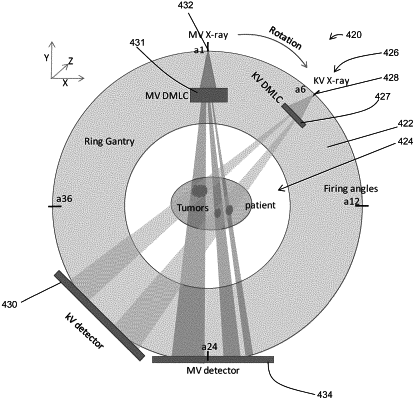| CPC A61N 5/1049 (2013.01) [A61B 34/10 (2016.02); A61N 5/1081 (2013.01); A61B 2034/105 (2016.02); A61B 2090/367 (2016.02); A61B 2090/373 (2016.02); A61N 2005/105 (2013.01); A61N 2005/1059 (2013.01); A61N 5/107 (2013.01); A61N 2005/1074 (2013.01); A61N 2005/1076 (2013.01)] | 40 Claims |

|
33. A radiation therapy sustem comprising:
a circular gantry comprising a stationary frame and a rotatable ring coupled to the stationary frame;
a therapeutic radiation source coupled to the rotatable ring;
an imaging system coupled to the rotatable ring, wherein the imaging system comprises a reflectometer configured to acquire image data of a patient area during rotation of the ring;
a patient platform movable in the patient area;
a controller in communication with the imaging system, wherein the controller is configured to process and store the acquired image data, generate a 3-D model of a patient within the patient area at a specified time interval using images acquired during the specified time interval, compare the 3-D model of the patient at the specified time interval and a 3-D model of the patient at an earlier time interval to identify a positional difference in the 3-D models, compare the identified difference in the 3-D models with a motion envelope, and generate a notification if the identified difference exceeds the motion envelope,
wherein the motion envelope is determined based on whether the patient platform is moving or stationary, wherein the motion envelope has a first range of motion when the patient platform is moving and has a second range of motion when the patient platform is stationary.
|